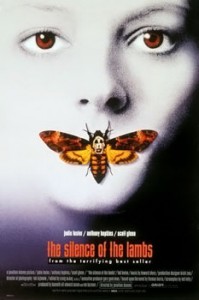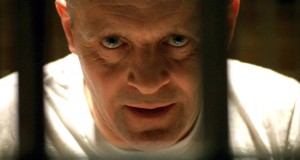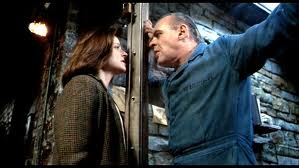 ”I find myself much more interested in satisfying large numbers of other people than in amusing myself. What has great potential for this film is Tom Harris’s book, Tom Harris’s story, his characters, and we don’t need some director coming in here and making it his own. We need slavish loyalty to the text and as a great, great fan of the book as I was, it was easy for me to translate my ardor for the book into my work.” — Director Jonathan Demme, from the Criterion DVD commentary track.
”I find myself much more interested in satisfying large numbers of other people than in amusing myself. What has great potential for this film is Tom Harris’s book, Tom Harris’s story, his characters, and we don’t need some director coming in here and making it his own. We need slavish loyalty to the text and as a great, great fan of the book as I was, it was easy for me to translate my ardor for the book into my work.” — Director Jonathan Demme, from the Criterion DVD commentary track.
I can’t believe it’s already been 20 years, but it was Valentine’s Day, 1991 when The Silence of the Lambs was released. It’s not easy these days (or even back in ’91) for me to be frightened by a movie, but Silence managed to create a feeling of dread in the first ten minutes and maintain it for a solid two hours. I’ve always felt that Jaws is the scariest movie ever made, but Silence falls on my list at a very respectable number two.
In 1981, Thomas Harris wrote the novel Red Dragon, which introduced the cannibalistic serial killer Dr. Hannibal Lecter. Harris followed this in 1988 with The Silence of the Lambs, which told the story of a young FBI agent-in-training Clarice Starling who is assigned to interview the incarcerated Lecter in hopes of finding clues to track a serial killer on the loose known as Buffalo Bill.
Harris’s terrific novel was adapted by Ted Tally, who was primarily known as a playwright at the time. His adaptation sticks mostly to the source, only deviating to add his own brilliant touches such as the line “I’m having an old friend for dinner.” Heh.
It was Orion Pictures co-founder Mike Medavoy who brought in director Jonathan Demme to the mix. It was a daring choice, because although Demme had previously made a thriller (1979’s Last Embrace), he was mainly known for directing comedies like Something Wild (1986) and Married to the Mob (1988), not to mention the outstanding Talking Heads concert film Stop Making Sense (1984).
Demme’s first choice for Clarice Starling was Michelle Pfeiffer, whom he had worked with in Married to the Mob. When she turned down the part (concerned about the violence), Demme cast Jodie Foster who had been actively campaigning for the role having read the book. And after Sean Connery passed on playing Hannibal Lecter, Demme sought out Anthony Hopkins. Rounding out the cast, but never really getting the accolades they deserve, are Scott Glenn as the head of the FBI Behavioral Science Unit Jack Crawford and — in one of the most disturbing portrayals of a serial killer ever captured on film — Ted Levine as Jame “Buffalo Bill” Gumb.
[kml_flashembed movie="http://www.youtube.com/v/WCSZfmbFJyQ" width="600" height="344" allowfullscreen="true" fvars="fs=1" /]
Demme belongs to an impressive group of directors who got their start working for Roger Corman (who has a cameo in Silence as the FBI director). He ended up directing three exploitation flicks for Corman: Caged Heat (1974), Crazy Mama (1975) and Fighting Mad (1976, the trailer for which I’ve included at the very end).
 In The Silence of the Lambs, Demme, along with his usual cinematographer Tak Fujimoto, create a very unsettling look with the frequent use of close-ups during conversations. Clarice Starling and Hannibal Lecter often stare directly into the camera during their scenes together, creating intimacy and tension even when the characters are mostly separated by glass.
In The Silence of the Lambs, Demme, along with his usual cinematographer Tak Fujimoto, create a very unsettling look with the frequent use of close-ups during conversations. Clarice Starling and Hannibal Lecter often stare directly into the camera during their scenes together, creating intimacy and tension even when the characters are mostly separated by glass.
There is a moment, about halfway through the film, where Lecter hands Starling a case file through prison bars. We see in glorious close-up Lecter’s finger lightly brushing against her finger and it is a goosebump-inducing moment as it is the only time in the entire movie where any physical contact is made between the two characters.
As is the case in most of Demme’s films, he populates the screen with a multitude of great character actors like Charles Napier, Tracey Walter, Paul Lazar, and Ron Vawter.
Approximately 78 minutes into the film, something most unusual happens. The two main characters vanish from the story while we follow a SWAT team securing an area from which Lecter is attempting escape. These are characters we’ve never seen before in the film but for the next seven minutes of screen time we’re stuck with them — and instead of grinding things to a halt, it becomes one of the most suspenseful sequences in the movie. The acting in this sequence is first-rate all around, particularly Danny Darst as Sergeant Tate — especially when, under tremendous stress, he barks out the order “It’s Jim Pembry, now talk to him, dammit!”
There are no wasted moments in the film. Even scenes that seem like they serve no purpose end up serving a purpose. Early on there is a short scene which shows Starling getting “killed” in a training exercise because she failed to check her “danger area” before entering a hostile situation. It might seem like a throwaway moment, but it sticks with us throughout the movie, adding to the overall feeling of dread, so that when Agent Starling does find herself in a bad situation, we remember that she is still just a trainee.
The moment where Clarice Starling and Jame Gumb finally meet is such a shocking line of prose in the book and in the film the same feeling of utter holy shititude is achieved in a cinematic way, assisted by some absolutely brilliant editing.
 The Silence of the Lambs became the third movie in Oscar history to win all of the top five categories: Best Picture, Best Actor, Best Actress, Best Director and Best Screenplay. The previous films were It Happened One Night (1934) and One Flew Over the Cuckoo’s Nest (1975). In 2001, Silence ranked number five on AFI’s 100 Years … 100 Thrills list.
The Silence of the Lambs became the third movie in Oscar history to win all of the top five categories: Best Picture, Best Actor, Best Actress, Best Director and Best Screenplay. The previous films were It Happened One Night (1934) and One Flew Over the Cuckoo’s Nest (1975). In 2001, Silence ranked number five on AFI’s 100 Years … 100 Thrills list.
Ted Tally went on to write the adaptation for Thomas Harris’s previous Lecter novel Red Dragon. Although it had already been filmed as Manhunter by director Michael Mann in 1986, fans of the book (such as myself) had always been disappointed by how much it had deviated from the source material. So, with its original title restored, Red Dragon was filmed in 2002 (by Rush Hour director Brett Ratner) with Anthony Hopkins reprising his role as Dr. Lecter.
As I’ve said previously in my write up for Black Sunday, Thomas Harris has an impressive number of film adaptations — to date, all five of his books have been made into a total of six movies.
Harris’s long-awaited sequel to The Silence of the Lambs, simply called Hannibal, came out in 1999 and was generally considered to be a disappointment — indeed, I’d personally call it a huge “fuck you” to fans. Jonathan Demme and Ted Tally both passed on participating in the film version, as did Jodie Foster. While Anthony Hopkins did return, Julianne Moore replaced Foster in the role of Clarice Starling. Hannibal, directed by Ridley Scott, was released February 9, 2001, just a few days shy of Valentine’s Day. Needless to say, there were no Oscars in its future.
20 years later, The Silence of the Lambs remains one of a kind.
[kml_flashembed movie="http://www.youtube.com/v/BjGpcEA-FyE" width="600" height="344" allowfullscreen="true" fvars="fs=1" /]
[kml_flashembed movie="http://www.youtube.com/v/xB7UzlszTNQ" width="600" height="344" allowfullscreen="true" fvars="fs=1" /]




Comments